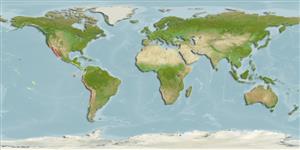Actinoptérygiens (poissons à nageoires rayonnées) >
Perciformes (Perch-likes) >
Gobiidae (Gobies) > Gobiinae
Etymology: Lythrypnus: Greek, lythros, -on = blood + Greek, hypnos = sleep (Ref. 45335).
Environnement / Climat / Gamme
Écologie
; marin démersal; profondeur 0 - 76 m (Ref. 2850). Subtropical; 18°C - 22°C (Ref. 27115), preferred ?
Eastern Pacific: Gulf of California to Ecuador and north of Perú.
Taille / Poids / Âge
Maturity: Lm ? range ? - ? cm
Max length : 6.4 cm TL mâle / non sexé; (Ref. 2850)
Found usually in open rocky areas but retreats to crevices or holes or hides among spines of sea urchins when threatened. Territorial. Sits on exposed rock surfaces near a hole or crevice. Feeds mainly on small crustaceans. Oviparous (Ref. 56079). Males guard the eggs which are found attached to the walls of brood chamber (Ref. 56079). Female deposits oblong eggs in empty shells; male guards them. Often found with Lythrypnus zebra.
Life cycle and mating behavior
Maturité | Reproduction | Frai | Œufs | Fécondité | Larves
Oviparous, demersal spawner (Ref. 101194). Both male and female spawn with many individuals in small contiguous territories (Ref. 240). Males guard the eggs which are found attached to the walls of brood chamber (Ref. 56079). Simultaneous hermaphrodite with varying allocation of reproductive tissue to male and female function (Ref. 31569). Bi-directional sex change has been confirmed for this species (Ref. 103751).
Eschmeyer, W.N., E.S. Herald and H. Hammann, 1983. A field guide to Pacific coast fishes of North America. Boston (MA, USA): Houghton Mifflin Company. xii+336 p. (Ref. 2850)
Statut dans la liste rouge de l'IUCN (Ref. 115185)
CITES (Ref. 94142)
Not Evaluated
Menace pour l'homme
Harmless
Utilisations par l'homme
Aquarium: Commercial
Plus d'informations
RéférencesAquacultureProfil d'aquacultureSouchesGénétiqueFréquences alléliquesHéritabilitéPathologiesTraitementMass conversion
Outils
Articles particuliers
Télécharger en XML
Sources Internet
